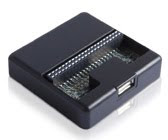I'd been waiting to get my hands on Bug Labs latest, Bugbundle. Once I had it in hand I spent too much time playing with it to write this. The BUGbase 2.0 (see Build with a Bug) is fun to work with and it is a flexible development platform.
There are a number of BugBundles starting with the $699 Embedded BUGbundle that includes the BUGbase 2.0 (Fig. 1), BUGstinger (Fig. 2) and BUGvonHippel module (Fig. 3). I took a look at the top end Pro bundle that adds BUGview LCD display (Fig. 4), 3 Mpixel BUGcam (Fig. 5), 720p HDMI output BUGvideo, BUGlocate GPS and BUGusb.
The BUGbase is 5.1-in by 2.55-in by 0.765-in with four pliug-in expansion ports, two on each side. A built-in rechargeable 3.7V, 1500 mAh lithium-ion battery supports mobile operation. The heart of the system is a 600 MHz Texas Instruments OMAP3530 processor. The OMAP3530 is based on an ARM Cortex A-8 processor. The system has access to 64 Gbytes of flash memory using a pair of MicroSD cards.
There is built-in audio support as well as wireless support that includes a 802.11b/g Wi-Fi interface, Bluetooth 2.0 support with EDR wireless technology. A cell phone 3G module is optional. The BUGstinger provides access to the USB host port, Ethernet and a serial port.
The hardware is modular with up to four modules supported by the BUGbase although there are two different kinds of connections. One is designed for video modules. Modules have hooks on one side and snap into place.
The modular system is useful but it is the software that makes things interesting. The system runs Linux but it is Java and the Java-based OSGi system (see Open Services Initiative: OSGi Links Devices And Clients) that make the difference. Each module comes with an OSGi bundle.
Developing A Bug
Like most eval platforms these days, Bug Labs puts all its tools, documentation, etc. online. Many also take advantage of open source software. In this case, BUGbase developers can take advantage of the Eclipse IDE (see Anatomy Of An IDE).
On the plus side, Eclipse can be used to develop C/C++ applications for the BUGbase or Java-based applications. I started out setting up the WiFi support with a fixed IP address and then I tried a Hello World style app just to try out the C++ support.
S:electronicdesign.com






EmoticonEmoticon